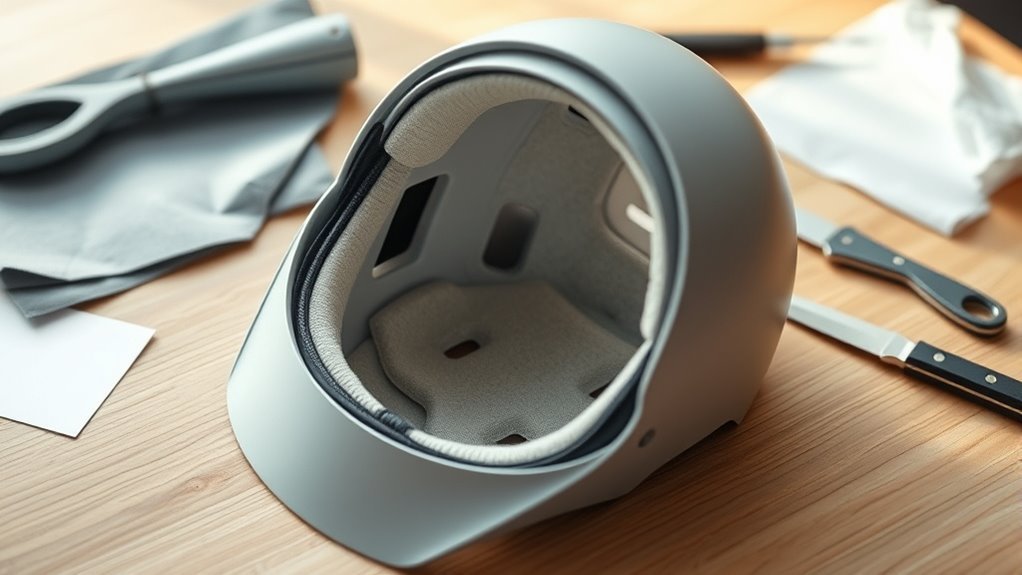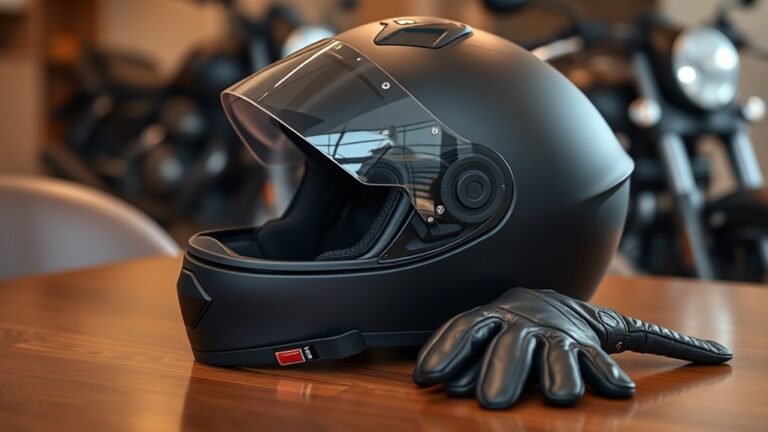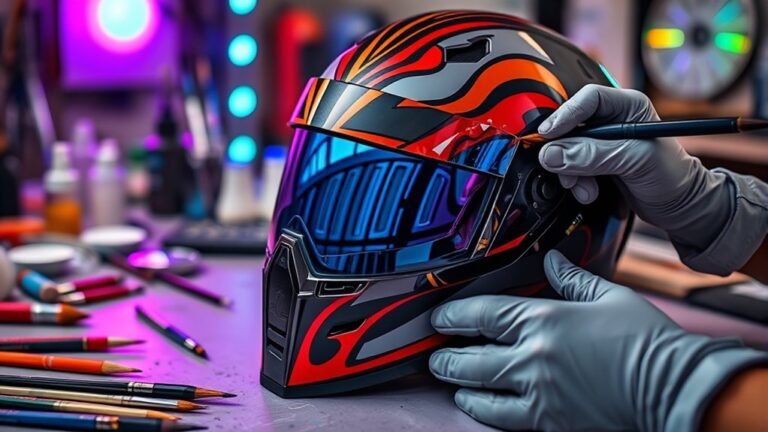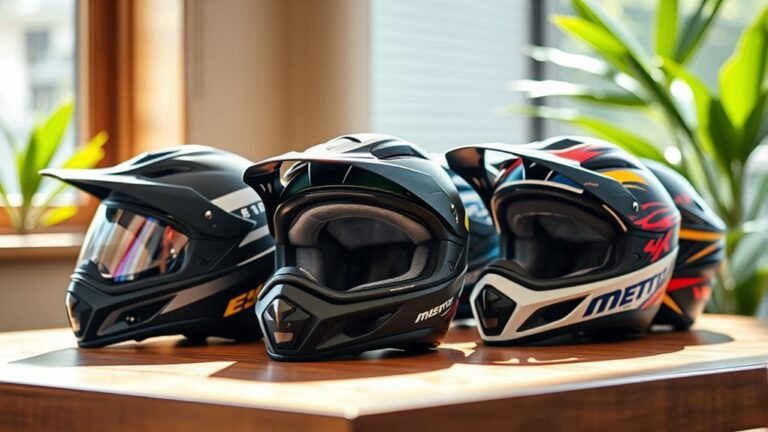How to Make a Lightweight Helmet for Comfort
To make a lightweight helmet for comfort, start by selecting materials like EPS for impact absorption and carbon fiber for strength. Begin with a foam core, adhere the outer shell, and create ventilation holes for airflow. Don’t forget a snug fit with adjustable straps and comfortable padding. Enhance visibility with reflective elements. Finally, to guarantee safety and durability, test your helmet and enjoy a comfortable ride—there’s much more to discover about helmet crafting!
Understanding the Importance of Lightweight Helmets
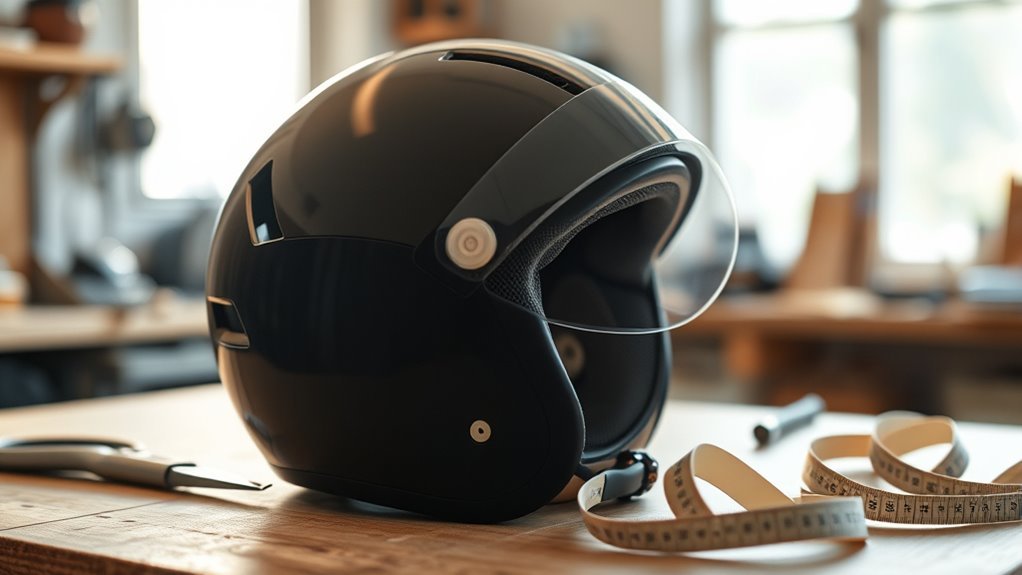
When you think about safety gear, it’s easy to overlook how important weight can be, but having a lightweight helmet can make all the difference in your comfort and performance. The right helmet design prioritizes not just protection, but also the freedom to move without feeling weighed down. Comfort features like breathable padding and adjustable straps enhance your experience, allowing you to focus on your ride instead of your gear. A lightweight helmet means you can wear it longer without fatigue, giving you the confidence to push your limits. Whether you’re hitting the trails or cruising through the city, choosing a helmet that combines safety with a featherlight feel is essential for a truly liberating experience.
Materials Needed for a Custom Lightweight Helmet
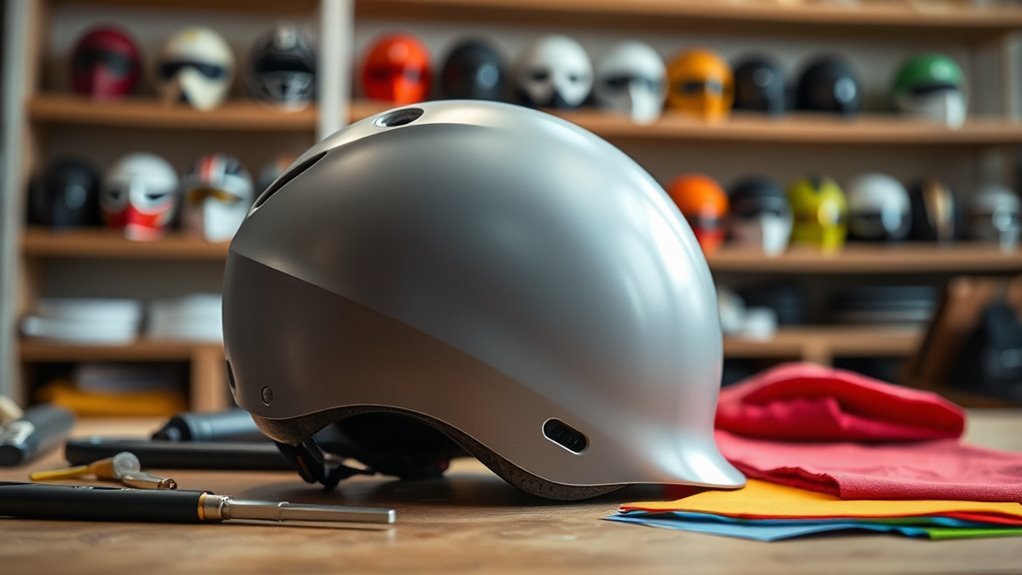
When you’re ready to create your custom lightweight helmet, choosing the right materials is vital. You’ll want to focus on options that not only reduce weight but also maintain safety and durability. Let’s explore essential materials and effective weight reduction techniques to get you started.
Essential Materials Overview
Creating a custom lightweight helmet begins with selecting the right materials. The materials you choose will directly impact both the helmet comfort and its performance. You’ll want to prioritize lightweight materials that don’t compromise safety. Here’s a quick list to get you started:
- Expanded Polystyrene (EPS): Excellent for impact absorption.
- Carbon Fiber: Lightweight and incredibly strong.
- Nylon or Polyester Fabric: Breathable and comfortable lining.
- Foam Padding: Essential for a snug fit and added comfort.
Weight Reduction Techniques
To achieve a truly lightweight helmet, you’ll need to implement various weight reduction techniques that not only enhance comfort but also maintain safety standards. Start with advanced foam types, like expanded polypropylene (EPP) or expanded polystyrene (EPS), which provide excellent impact protection without excessive weight. Incorporate strategic cutouts to improve ventilation and further reduce mass, ensuring an ideal weight distribution across the helmet. Consider using a composite shell made of carbon fiber or Kevlar; these materials are strong yet light. Finally, focus on a minimalist design, eliminating unnecessary features while ensuring essential safety elements remain intact. By creatively combining these techniques, you’ll enjoy the freedom of movement and comfort that a lightweight helmet can provide.
Step-by-Step Guide to Crafting Your Helmet
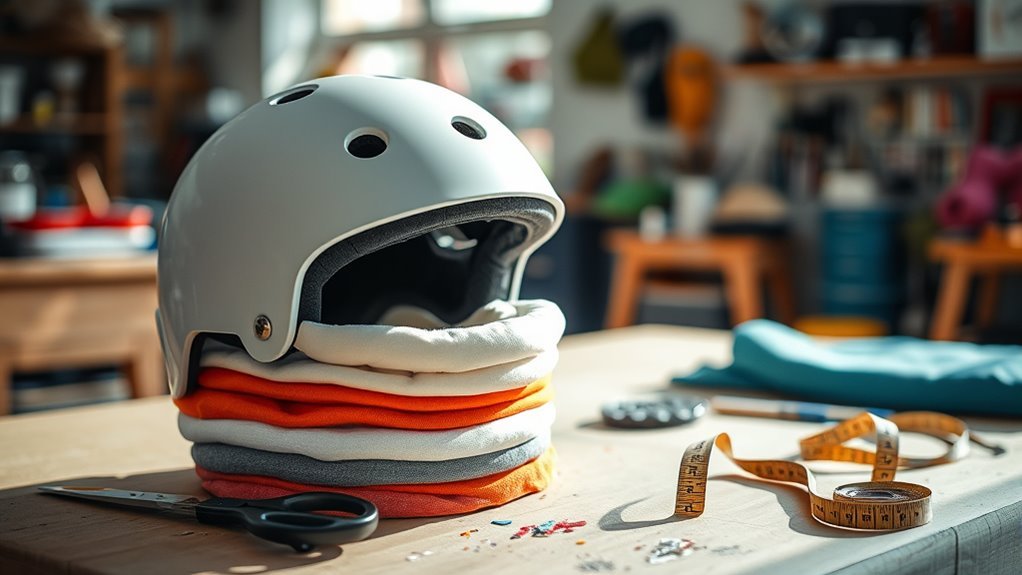
Now that you’ve gathered your materials, it’s time to get hands-on with the assembly process. You’ll want to follow each step carefully to guarantee your helmet not only looks great but also meets essential safety features. Let’s get started on crafting a helmet that’s both lightweight and protective!
Materials Needed for Construction
When you’re ready to build your lightweight helmet, gathering the right materials is essential for both safety and comfort. You want to make certain your helmet is not only protective but also eco-friendly. Here’s what you’ll need:
- Advanced composites for durability and lightweight structure
- EVA foam for cushioning and comfort against your head
- Eco-friendly fabrics for the inner lining, adding breathability
- Adjustable straps to make certain a snug fit
Choosing these materials will create a helmet that feels good and does good, giving you the freedom to ride or engage in activities without sacrificing safety. Remember, it’s all about combining innovation with practicality to get the best experience on your adventures!
Assembly Process Explained
Creating your lightweight helmet involves a series of straightforward steps that blend innovation with practicality. Start by selecting your base material; a foam core is ideal for comfort. Using effective assembly techniques, adhere the outer shell to the foam, ensuring a snug fit. This is where you can get creative with helmet modifications—adding ventilation holes can enhance airflow. Next, secure the chin strap, making sure it’s adjustable for your comfort. Don’t forget to test the fit; it should feel secure but not restrictive. Finally, personalize your helmet with paint or decals to reflect your style. With these steps, you’re not just making a helmet; you’re crafting a piece of freedom that’s uniquely yours!
Safety Features to Consider
While you’re crafting your lightweight helmet, prioritizing safety features is essential to guarantee maximum protection during use. Here are some key aspects to take into account:
- Impact Resistance: Choose materials that can absorb shocks effectively, ensuring your helmet withstands potential collisions.
- Ventilation Design: Incorporate adequate airflow to keep your head cool during long rides, preventing overheating.
- Fit and Comfort: Ensure a snug fit to keep the helmet secure without compromising comfort.
- Reflective Elements: Add reflective materials for visibility in low-light conditions, enhancing safety on the road.
Ensuring Proper Fit and Comfort
A well-fitted helmet can make all the difference between comfort and discomfort during your ride. To guarantee that perfect fit, start with proper fit adjustment. Many helmets come with adjustable straps or a dial system—use these to customize the snugness around your head. Don’t forget to pay attention to how the helmet sits; it should rest comfortably on your forehead without sliding or pinching.
Next, add comfort padding. High-quality padding can absorb sweat and reduce pressure points, making those long rides feel effortless. Choose materials that are breathable and moisture-wicking. Remember, a helmet shouldn’t just protect you; it should enhance your freedom while riding. By prioritizing fit and comfort, you’ll enjoy every moment on the road or trail.
Testing the Helmet for Safety and Durability
Before hitting the road or trail, it’s crucial to test your helmet for safety and durability, verifying it meets the necessary standards to protect you during your rides. You want freedom without the worry, so consider these key assessments:
- Impact Testing: Check how well your helmet withstands sudden impacts.
- Durability Assessment: Evaluate the materials over time to confirm they don’t degrade.
- Fit Verification: Ascertain the helmet stays snug even during movement.
- Ventilation Check: Make certain it allows airflow, keeping you cool on long rides.
Maintenance Tips for Longevity and Performance
To guarantee your lightweight helmet remains in top shape for years, regular maintenance is essential. Start with simple maintenance routines like cleaning the exterior with mild soap and water, avoiding harsh chemicals that could degrade materials. Inspect the straps and padding for wear and tear during your performance checks—this guarantees safety and comfort. If you notice any damage, address it immediately to maintain the helmet’s integrity. Store your helmet in a cool, dry place, away from direct sunlight, to prevent material degradation. Finally, keep track of your helmet’s age and consider replacing it after a few years or after a significant impact. By following these tips, you’ll enjoy freedom and confidence while riding!
Frequently Asked Questions
Can I Use Recycled Materials for My Lightweight Helmet?
Absolutely, you can use recycled materials to create a lightweight helmet! By opting for sustainable materials, you’re not just crafting a comfortable helmet, but also promoting environmental responsibility. Just guarantee that whatever materials you choose meet helmet safety standards, as safety shouldn’t be compromised for innovation. With creativity, you can design a helmet that’s both eco-friendly and stylish, giving you the freedom to express yourself while staying safe on your adventures.
How Much Does a Custom Lightweight Helmet Typically Cost?
A custom lightweight helmet typically costs anywhere from $150 to $500, depending on the materials and design. Imagine slipping on a helmet that feels like a whisper on your head, crafted from advanced lightweight materials that offer both protection and freedom. Custom helmet pricing can vary, but investing in one means embracing comfort and safety, allowing you to ride with confidence. You deserve the best—don’t settle for anything less!
Are There Any Specific Tools Required for Crafting?
When you’re crafting a lightweight helmet, you’ll need some essential tools. Basic items like a heat gun, molding tools, and safety scissors are a must. Consider safety goggles and gloves to protect yourself while using these crafting techniques. Don’t forget to keep ventilation in mind, especially when working with materials that emit fumes. With the right tools and precautions, you can create a comfortable helmet and enjoy the freedom of your adventurous pursuits!
What Are the Common Mistakes to Avoid During Assembly?
During assembly, avoid rushing; take your time to guarantee everything fits perfectly. One common mistake is poor material selection—always choose lightweight, durable options. Also, don’t forget to double-check your measurements; a small error can lead to discomfort. Use assembly tips like starting with a solid framework before adding layers. Finally, keep an eye on weight distribution to maintain balance—it’s essential for comfort and freedom while wearing your helmet.
Can I Paint or Decorate My Helmet Afterwards?
Absolutely, you can paint or decorate your helmet afterwards! Just make sure to use helmet painting techniques that won’t compromise its safety. Consider spray paint or vinyl wraps for a smooth finish. For decoration ideas, stickers, decals, or even custom designs can express your personality. Just remember to keep ventilation and visibility in mind while you’re at it! Get creative and make your helmet truly yours while ensuring it remains functional and safe.
